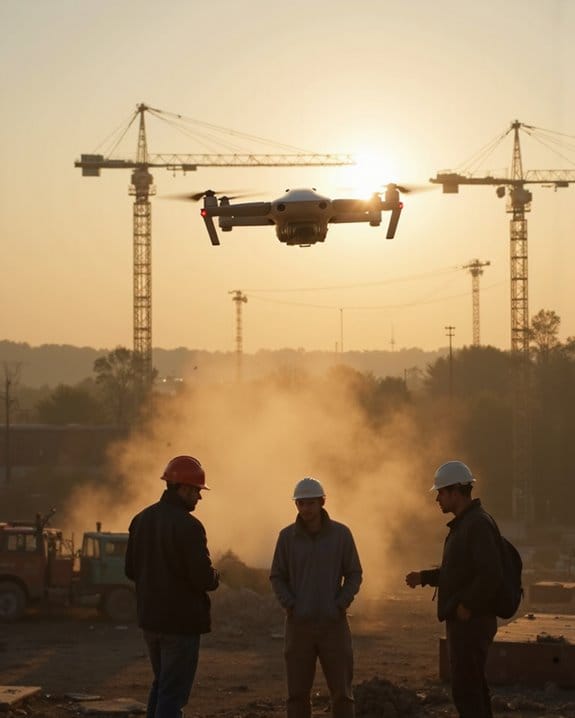Drones won’t just take away jobs—they’ll change them. You’ll see roles like crop inspection or delivery driving shrink as drones automate routine tasks, but demand will rise for drone operators, data analysts, engineers, and technicians. With the global drone market booming, new opportunities pop up in manufacturing, software, and maintenance. If you upskill, get certified, and adapt, you’re ahead. Curious how drones could reshape your career or business? The details in the next sections will guide you.
Key Takeaways
- Drones automate many routine and low-skill jobs, putting roles in delivery, agriculture, and inspection at risk of displacement.
- For every job lost to drones, up to two new roles may be created in areas like drone operation, maintenance, and data analysis.
- The global drone market is rapidly expanding, projected to grow 38% annually through 2030, fueling new employment opportunities.
- Workers can adapt by upskilling, earning certifications, and focusing on roles requiring drone management, data interpretation, or technical maintenance.
- Overall, while drones will displace some jobs, economic analyses suggest net employment growth if the workforce adapts to new demands.
What Are Drones and How Are They Used?
Drones—those sleek, pilotless aircraft you’ve probably seen buzzing overhead—are more than just high-tech toys. As unmanned aerial vehicles, a drone operates without a pilot or passengers, either remotely or autonomously. You’ll find drones in a range of sizes: some as large as model airplanes, others compact enough to fit in your pocket. The use of drones spans multiple industries, thanks to their versatility.
Common Uses of Drones:
- Capturing high-resolution photos and videos for real estate or filmmaking
- Mapping large areas for environmental research
- Surveying construction sites with pinpoint accuracy
Originally developed for military purposes, drones have now become indispensable in civilian sectors. Whether you’re an amateur photographer or a professional surveyor, there’s a drone designed for your needs. Many modern drones come equipped with advanced features like GPS navigation and automated flight modes to enhance usability and safety.
The Growth of the Drone Market
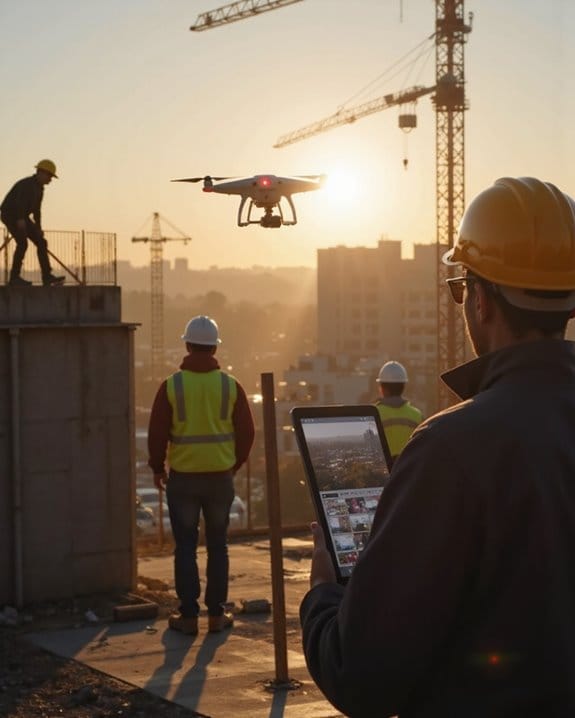
Although drones have quickly moved from niche gadgets to mainstream tools, the real story lies in the explosive growth of the drone market itself. The global commercial drone market soared to $30 billion in 2022, and projections show a staggering 38% compound annual growth rate through 2030. What’s fueling this surge? It’s a blend of relentless technology advances—think smarter computing and AI—and manufacturers constantly upping their game. As drones become more reliable, they’re finding their way into inspections, mapping, and surveying across industries.
Key Drivers in the Drone Industry:
- Expanding business applications
- Advancements in drone technology and AI
- Ongoing upgrades by hardware and software providers
With such rapid innovation, you’ll see new opportunities that don’t just replace jobs—they create jobs, too. The drone industry is anything but static, offering intelligent features that enhance efficiency and open new business possibilities.
Automation and the Shifting Landscape of Work

How exactly will automation reshape the world of work as drones become more commonplace? Let’s break it down. When drones powered by Artificial Intelligence step in, certain jobs—especially repetitive or low-skill ones—face higher risks of automation. History proves this; just look at the British Industrial Revolution. Today, similar patterns emerge as drones reduce the need for direct human intervention in tasks like monitoring crops or inspecting infrastructure.
However, it’s not all doom and gloom. Automation often leads to new jobs, especially in areas that require you to work alongside technology.
Key impacts:
- Jobs requiring routine tasks decline.
- Demand grows for workers who can manage, program, or maintain drones.
- Lower-educated workers are most vulnerable, so skill-building is essential.
Adaptability is your best defense in this shifting landscape. For instance, agricultural drones such as the DJI and G11PRO models demonstrate how advanced technology enhances efficiency but also creates new technical roles in agricultural monitoring.
New Job Opportunities in Drone Manufacturing and Sales

While automation may phase out some roles, it’s also powering a surge in new job opportunities—especially in drone manufacturing and sales. If you’re watching the drone market, you’ll notice a steady rise in jobs as production scales. Let’s break it down:
Product Overview:
- Each drone relies on at least 16 specialized components.
- Advancements in microcontrollers, cameras, and computing mean new roles in assembly, supply chain management, and quality control.
Detailed Analysis:
- Engineers and technicians are needed for innovative manufacturing.
- Sales and marketing teams must understand a vast range of drone types and applications.
Recommendations:
- If you enjoy technology, consider drone production.
- Prefer people skills? Sales and marketing roles create more jobs as companies target new markets.
The drone industry’s growth is anything but up in the air.
Expanding Roles in Software Engineering and Artificial Intelligence
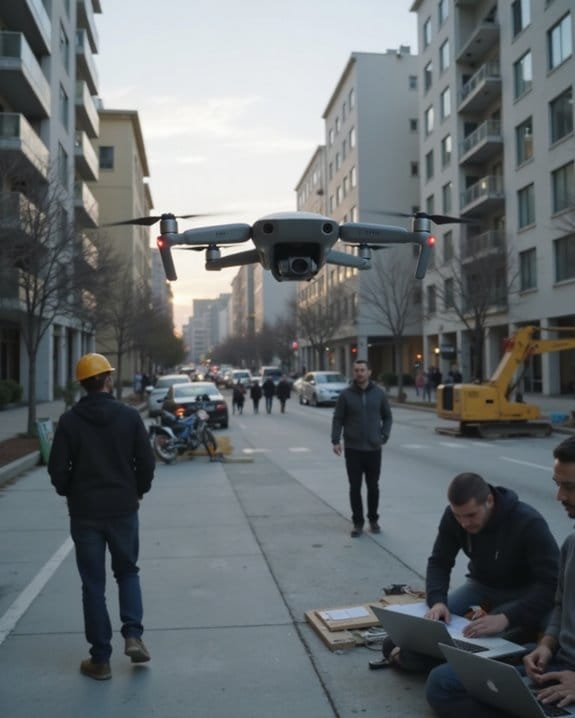
Ever wondered what’s powering drones to fly smarter, safer, and further than ever? It’s the rapid evolution in software engineering and artificial intelligence, with machine learning at the core. You’ll find that roles are expanding for those who can design algorithms for real-time decision-making, helping drones navigate unpredictable environments—think crowded construction sites or complex urban landscapes.
Key Innovations:
- AI Interfaces: Developers craft interfaces that let drone operators guide drones with precision, steering past obstacles and adjusting to changing conditions.
- Computer Vision: Software engineers use machine learning to improve obstacle recognition, enhancing drone piloting safety.
- Measurement Tools: New AI-driven features allow drones to calculate area and volume, offering powerful tools for construction sites.
If you’re tech-savvy, this field’s career runway is wide open.
Operations, Maintenance, and Support Careers
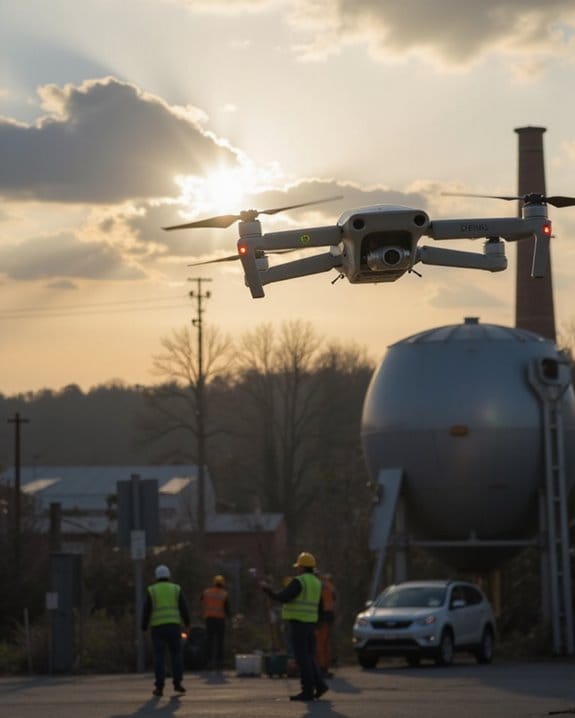
Behind every successful drone flight, there’s a network of skilled professionals working in operations, maintenance, and support. If you’re considering a career as a drone pilot or want to use drones in your industry, you’ll find opportunities beyond just flying. Here’s a breakdown:
Key Roles:
- Data Entry: Manage and verify drone-collected images and videos, supporting industries like construction.
- Drone Pilots: Safely navigate drones in tough environments, anticipating potential problems.
- Aerial Photography/Videography: Capture unique perspectives for real estate or emergency response.
- Integration & Testing: Assemble and configure drones, ensuring all 16+ components work together.
- Repair & Maintenance: Troubleshoot hardware and software when using drones, keeping fleets reliable.
Whether you’re detail-oriented or hands-on, supporting drone operations means job security—no crash course needed.
Drones and Workplace Safety: Enhancing Rather Than Replacing
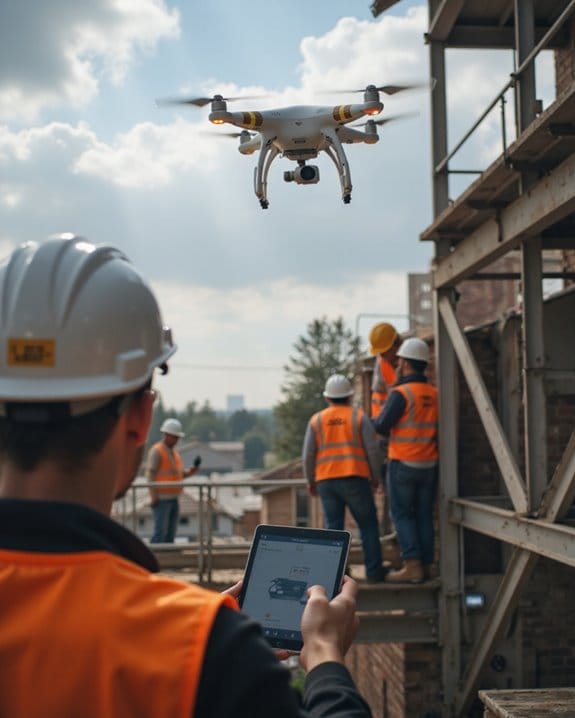
After exploring the many hands-on and technical roles supporting drone operations, it’s worth looking at how drones are actively making job sites safer. If you work in construction, manufacturing, or logistics, the use of drones is reshaping workplace safety in different industries. Here’s how the drone space enhances—not replaces—your role:
Specifications and Capabilities:
- Thermal inspections: Drones reach hazardous, inaccessible spots.
- Obstacle avoidance: Enables safe indoor navigation, even in tight warehouse aisles.
- Real-time aerial monitoring: Quickly identifies safety risks.
Comparisons:
- Traditional methods: Workers exposed to toxins or high heat.
- With drones: Employees remain out of danger, while drone know lets you focus on decision-making.
Recommendations:
- Use drones for inspections and monitoring.
- Leverage complementary skills to stay relevant in the evolving drone space.
Preparing the Workforce for a Drone-Driven Future
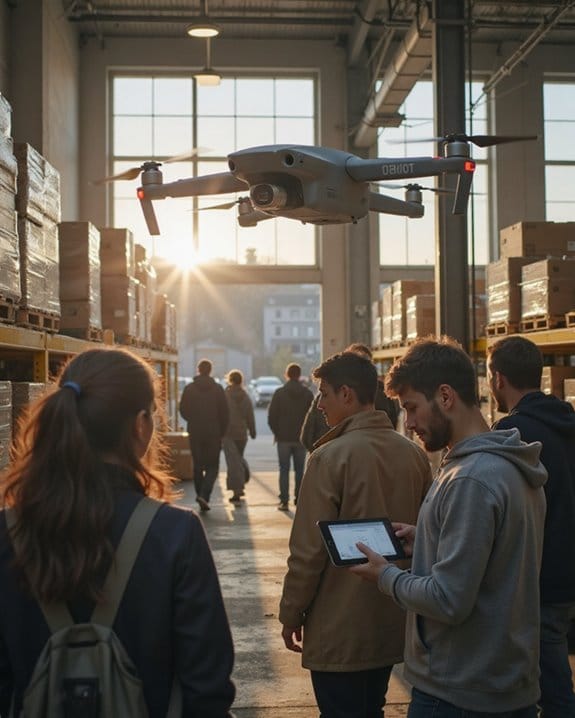
How can you make sure you’re ready for a future where drones are as common as hard hats on a job site? You’ll need to create a strategy that goes beyond just flying drones. Start by earning your FAA Part 107 certification—study 1-2 hours daily for two weeks and you’re set. Altitude University’s 99% pass rate says every new learner has a shot. Don’t stop there; flexibility counts. Learn drone data collection, thermal imaging, or even maintenance. With new roles in drone manufacturing, you’ll stay relevant.
Use Social Media to showcase your skills and connect with industry leaders. Highlight certifications, share project results, and join discussions. The workforce’s future depends on how you adapt—so create your niche before drones do it for you.
Frequently Asked Questions
What Is the Future Outlook for Drone-Related Career Paths?
You’ll find the future of drone-related careers promising, with expanding opportunities in engineering, AI, piloting, and maintenance. As industries adopt drones, you’ll see diverse, specialized roles and accessible certification pathways fueling long-term professional growth.
Will Robots Reduce or Increase Human Employment Opportunities?
You’re wondering if robots will reduce or increase human employment opportunities. While some jobs might disappear, you’ll see new roles emerge in programming, maintenance, and supervision, so overall, you can expect more diverse opportunities in the future.
How Is AI Going to Affect Jobs?
Imagine you’re riding a penny-farthing into the future—AI’s poised to change how you work. You’ll see some jobs disappear, but you’ll also find new opportunities popping up, especially if you adapt and reskill quickly.
What Are the Top 3 Paying Careers Involving Drones?
If you’re aiming for top-paying drone careers, focus on becoming a certified commercial drone pilot, a drone software engineer specializing in AI, or an expert in drone AI and machine learning for advanced data analysis and computer vision.

